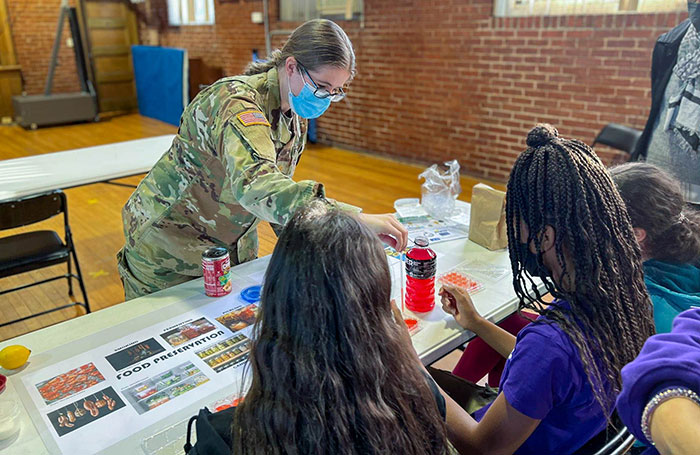USAMRDC Partners with ECLN to Provide STEM Opportunities for Local Community

During the past two months, the U.S. Army Medical Research and Development Command's Outreach and Partnerships office has been working with the Sisters Wholesome Aspiring towards Greatness, or SWAG program of the Empowering Community Leaders Network to supply volunteers for Science, Technology, Engineering and Math education nights to provide hands-on instruction for middle-school girls throughout Frederick County, Maryland.
Soldiers and Civilians from the U.S. Army Telemedicine & Advanced Technology Research Center and the U.S. Army Medical Research Institute of Infectious Diseases hosted the STEM-related activities.
TATRC's Deputy Director, Lt. Col. Sharon Rosser, and Medical Modeling, Simulation, Informatics and Visualization Division Chief, Maj. Patty Schmidt, offered inspiring and engaging discussions on the topic of "Check. Call. Care." as well as the basics of emergency situation safety and assessment.
Known as the "three C's of emergency," "Check" means checking for anything unsafe in the environment and checking the injured; "Call" means contacting first responders as soon as possible; and "Care" means providing care to the injured until medical professionals arrive on the scene.
"I fully enjoyed the opportunity to spend an afternoon with the young middle school ladies from the ECLN SWAG program in Frederick," said Rosser. "This opportunity to inspire these bright young ladies to pursue a career in a STEM discipline is among my favorite activities that always fills my cup."
Volunteers from USAMRIID led the students through a workshop consisting of four different stations centered on the concept of "Farm to Table," and the role of veterinarians within this concept. Students were provided with infographic handouts and a selection of hands-on materials that emphasized the important points for each individual station.
Veterinarians, particularly those in the military and industry (large food productions companies, pharmaceutical development), play a major role in getting food from "Farm to Table" in a safe and wholesome manner for you to enjoy. While initially focused solely on animal husbandry and meat inspection, today's food inspection veterinary professionals work with many others in the scientific community – medical doctors, engineers, researchers – to ensure that all components of the food chain are safe and wholesome.
USAMRIID's volunteers included veterinary pathologists, Lt. Col. Diana Hoffman and Maj. Brittany Beavis, and animal care specialists, Spc. Amanda Casselman, Spc. Summer Astleford, Spc. Melanny Rodriguez Vazquez and Spc. Cheyanne Everett.
"As a young woman, I had no idea about the opportunities available in science or the Army, or at the intersection of the two," said Beavis. "It is only through the mentorship of my college advisor that I discovered the important and exciting work done by Army scientists. Presentations like ECLN SWAG allow me to pass on these opportunities to the next generation of women scientists."
USAMRIID hosted an additional STEM night for SWAG members, during which volunteers Ms. Holly Bloomfield, Dr. Keersten Ricks, Cpt. Riley Sennett and Spc. Marjorie Torres led the students through three different stations that covered the topics of biocontainment, diagnostics and bacteriology.
Biocontainment laboratories are labs where scientists safely study some of the world's most hazardous viruses, while diagnostic tests are the first step to understanding a new disease in order to respond to an outbreak. Finally, bacteriology is the branch and specialty of biology that studies the morphology, ecology, genetics and biochemistry of bacteria, as well as many other related aspects.
At the completion of all three stations, each of the four presenters introduced herself, providing a brief background of her respective education and career path and what led her to choose a profession in the field of science.
"Outreach to younger generations has always been something that is important to me," said Ricks. "I was fortunate enough to come from a supportive family that encouraged me to go after whatever I put my mind to, and encouraged me to seek out STEM opportunities–and that was before STEM was even a thing."
"Now that I have a budding career in science," she continued, "I always love opportunities to speak to K through 12 students about why science is cool and how they can start down a path of learning and research from an early age. I would not be where I am today if I didn't have the support of teachers, mentors and my parents, so I want to give that back as best I can."














